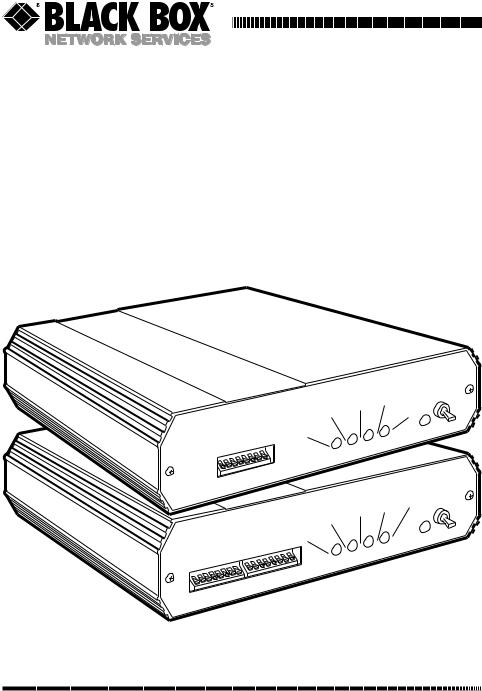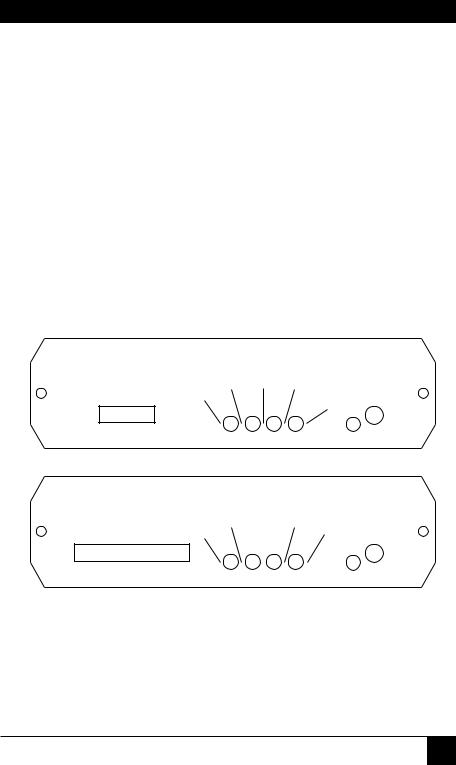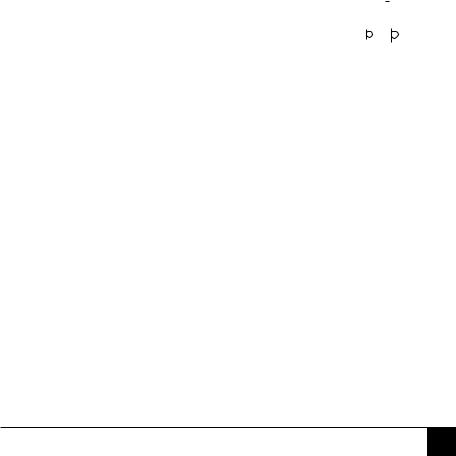Black Box PQ-8S, PQ-8P User Manual

OCTOBER 1995
PCA45A
PCA45AE
PCA46A
PCA46AE
PQ-8P
PQ-8S
PQ |
-8P |
I
O
|
|
Data |
Data |
|
|
From |
|
|
Printer |
From |
Parallel |
Host |
On |
Host |
|
Line |
Line |
|
|
Sync |
|
|
|
|
|
|
SW1 |
|
|
I |
|
|
|
|
|
|
|
||
|
|
|
|
|
|
|
O |
|
|
|
|
5 |
6 |
7 |
8 |
|
|
3 |
4 |
|
|
||
|
2 |
|
|
|
|||
1 |
|
|
|
|
|
||
|
|
|
|
|
|
||
|
|
|
|
|
|
|
|
On
Power
Off
I
O
|
|
|
|
|
|
|
|
|
|
|
SW2 |
|
|
I |
|
|
|
|
|
|
|
|
|
|
|
|
|
|
|
||
|
|
|
SW1 |
|
|
|
|
|
|
|
|
|
|
O |
|
|
|
|
|
|
|
|
|
|
|
|
|
5 |
6 |
7 |
8 |
|
|
|
|
|
|
|
|
|
|
|
4 |
|
|||
|
|
|
|
|
|
|
|
|
|
3 |
|
|
|||
|
|
|
|
|
|
|
|
1 |
2 |
|
|
|
|
||
|
|
|
|
|
|
|
8 |
|
|
|
|
|
|||
|
|
|
|
|
|
7 |
|
|
|
|
|
|
|||
|
|
|
|
5 |
6 |
|
|
|
|
|
|
|
|
||
|
|
|
4 |
|
|
|
|
|
|
|
|
|
|||
|
|
3 |
|
|
|
|
|
|
|
|
|
|
|||
1 |
2 |
|
|
|
|
|
|
|
|
|
|
|
|
||
|
|
|
|
|
|
|
|
|
|
|
|
|
|||
|
|
|
|
|
|
|
|
|
|
|
|
|
|
|
|
|
Printer |
Data Data |
||
|
From |
Out |
||
Host |
On |
Host |
||
|
||||
Line |
Line |
|
|
|
Sync |
|
|
|
|
Power
Off
CUSTOMER Order toll-free in the U.S. 24 hours, 7 A.M. Monday to midnight Friday: 877-877-BBOX SUPPORT FREE technical support, 24 hours a day, 7 days a week: Call 724-746-5500 or fax 724-746-0746
INFORMATION Mail order: Black Box Corporation, 1000 Park Drive, Lawrence, PA 15055-1018 Web site: www.blackbox.com • E-mail: info@blackbox.com

FCC STATEMENT
FEDERAL COMMUNICATIONS COMMISSION
AND
INDUSTRY CANADA
RADIO FREQUENCY INTERFERENCE STATEMENTS
This equipment generates, uses, and can radiate radio frequency energy and if not installed and used properly, that is, in strict accordance with the
manufacturer’s instructions, may cause interference to radio communication. It has been tested and found to comply with the limits for a Class A computing device in accordance with the specifications in Subpart J of
Part 15 of FCC rules, which are designed to provide reasonable protection against such interference when the equipment is operated in a commercial environment. Operation of this equipment in a residential area is likely to cause interference, in which case the user at his own expense will be required to take whatever measures may be necessary to correct the interference.
Changes or modifications not expressly approved by the party responsible for compliance could void the user’s authority to operate the equipment.
This digital apparatus does not exceed the Class A limits for radio noise emission from digital apparatus set out in the Radio Interference Regulation of Industry Canada.
Le présent appareil numérique n’émet pas de bruits radioélectriques dépassant les limites applicables aux appareils numériques de classe A prescrites dans le Règlement sur le brouillage radioélectrique publié par Industrie Canada.
3

INSTRUCCIONES DE SEGURIDAD
NORMAS OFICIALES MEXICANAS (NOM)
ELECTRICAL SAFETY STATEMENT
INSTRUCCIONES DE SEGURIDAD
1.Todas las instrucciones de seguridad y operación deberán ser leídas antes de que el aparato eléctrico sea operado.
2.Las instrucciones de seguridad y operación deberán ser guardadas para referencia futura.
3.Todas las advertencias en el aparato eléctrico y en sus instrucciones de operación deben ser respetadas.
4.Todas las instrucciones de operación y uso deben ser seguidas.
5.El aparato eléctrico no deberá ser usado cerca del agua—por ejemplo, cerca de la tina de baño, lavabo, sótano mojado o cerca de una alberca, etc..
6.El aparato eléctrico debe ser usado únicamente con carritos o pedestales que sean recomendados por el fabricante.
7.El aparato eléctrico debe ser montado a la pared o al techo sólo como sea recomendado por el fabricante.
8.Servicio—El usuario no debe intentar dar servicio al equipo eléctrico más allá a lo descrito en las instrucciones de operación. Todo otro servicio deberá ser referido a personal de servicio calificado.
9.El aparato eléctrico debe ser situado de tal manera que su posición no interfiera su uso. La colocación del aparato eléctrico sobre una cama, sofá, alfombra o superficie similar puede bloquea la ventilación, no se debe colocar en libreros o gabinetes que impidan el flujo de aire por los orificios de ventilación.
10.El equipo eléctrico deber ser situado fuera del alcance de fuentes de calor como radiadores, registros de calor, estufas u otros aparatos (incluyendo amplificadores) que producen calor.
4

INSTRUCCIONES DE SEGURIDAD
11.El aparato eléctrico deberá ser connectado a una fuente de poder sólo del tipo descrito en el instructivo de operación, o como se indique en el aparato.
12.Precaución debe ser tomada de tal manera que la tierra fisica y la polarización del equipo no sea eliminada.
13.Los cables de la fuente de poder deben ser guiados de tal manera que no sean pisados ni pellizcados por objetos colocados sobre o contra ellos, poniendo particular atención a los contactos y receptáculos donde salen del aparato.
14.El equipo eléctrico debe ser limpiado únicamente de acuerdo a las recomendaciones del fabricante.
15.En caso de existir, una antena externa deberá ser localizada lejos de las lineas de energia.
16.El cable de corriente deberá ser desconectado del cuando el equipo no sea usado por un largo periodo de tiempo.
17.Cuidado debe ser tomado de tal manera que objectos liquidos no sean derramados sobre la cubierta u orificios de ventilación.
18.Servicio por personal calificado deberá ser provisto cuando:
A:El cable de poder o el contacto ha sido dañado; u
B:Objectos han caído o líquido ha sido derramado dentro del aparato; o
C:El aparato ha sido expuesto a la lluvia; o
D:El aparato parece no operar normalmente o muestra un cambio en su desempeño; o
E:El aparato ha sido tirado o su cubierta ha sido dañada.
5

PQ-8P, PQ-8S
TRADEMARKS
Centronics® is a a registered trademark of Centronics Corporation. Epson® is a registered trademark of Seiko Epson Corporation. HP® and PCL® are registered trademarks of Hewlett-Packard.
IBM®, AS/400®, and Proprinter® are registered trademarks of IBM Corporation.
Lexmark™ is a trademark of Lexmark International.
All applied-for and registered trademarks are the property of their respective owners.
6

PQ-8P, PQ-8S
Contents
Chapter |
Page |
||
1. |
Specifications....................................................................................... |
10 |
|
2. |
Introduction ........................................................................................ |
11 |
|
|
2.1 |
Description of Front Panels ......................................................... |
12 |
|
2.2 |
About This User’s Guide.............................................................. |
12 |
|
2.3 |
Unpacking..................................................................................... |
13 |
3. |
Installation ........................................................................................... |
14 |
|
|
Printer On/Off Sequence.................................................................. |
16 |
|
4. |
Configuration ...................................................................................... |
20 |
|
|
4.1 |
Host Configuration....................................................................... |
20 |
|
4.2 |
PQ-8 Configuration ...................................................................... |
21 |
|
|
4.2.1 Switch Settings ................................................................... |
21 |
|
|
4.2.2 Setup Software ................................................................... |
27 |
|
4.3 Host/PC Download Commands .................................................. |
27 |
|
|
4.4 |
Configuration Options................................................................. |
32 |
|
4.5 |
Restoring Factory Defaults ........................................................... |
47 |
5. Operation............................................................................................. |
48 |
||
|
5.1 |
Serial Printing ............................................................................... |
48 |
|
5.2 |
Printer Sharing ............................................................................. |
48 |
|
5.3 |
Parallel/Serial-Port Initialization ................................................ |
49 |
|
5.4 |
Host Printing................................................................................. |
49 |
|
5.5 |
Host-Port Initialization................................................................. |
49 |
|
5.6 |
Star Panel Overdrive..................................................................... |
49 |
|
5.7 |
Laser Printer Operation............................................................... |
50 |
|
|
5.7.1 Changing Typestyles .......................................................... |
52 |
|
|
5.7.2 Font-Change Commands................................................... |
52 |
|
|
5.7.3 Page Length ....................................................................... |
53 |
|
|
5.7.4 Paper Size ........................................................................... |
54 |
|
|
5.7.5 Printing on 11" x 17" or A3 Size Paper............................. |
55 |
|
|
5.7.6 Paper-Drawer Selection ..................................................... |
55 |
|
5.8 |
Print Orientation .......................................................................... |
57 |
|
|
5.8.1 Page Rotation ..................................................................... |
57 |
|
|
5.8.2 Automatic Print Orientation............................................. |
58 |
|
|
5.8.3 Print-Orientation Settings ................................................. |
58 |
|
|
5.8.4 Changing Page-Rotation Settings ..................................... |
64 |
7

PQ-8P, PQ-8S
Chapter |
Page |
|
5.9 |
Envelope Printing......................................................................... |
65 |
5.10 Document/Envelope Printing................................................... |
66 |
|
5.11 Duplex Printing .......................................................................... |
67 |
|
5.12 Other Printer Commands .......................................................... |
68 |
|
5.13 HP Line Printer .......................................................................... |
70 |
|
5.14 Matrix/Specialty Printer Operation.......................................... |
70 |
|
|
5.14.1 IBM Matrix Printer Emulations ...................................... |
70 |
|
5.14.2 Character Set.................................................................... |
71 |
|
5.14.3 Print Quality ..................................................................... |
71 |
|
5.14.4 Pitch Control.................................................................... |
71 |
|
5.14.5 Graphics Printing............................................................. |
71 |
|
5.14.6 Truncate/Wrap................................................................ |
72 |
|
5.14.7 True 15 CPI ...................................................................... |
72 |
|
5.14.8 Generic Mode .................................................................. |
73 |
6. Advanced Features .............................................................................. |
74 |
|
6.1 Command Pass-Thru .................................................................... |
74 |
|
6.2 |
User-Defined Strings .................................................................... |
75 |
6.3 |
User-Defined Fonts (HP PCL only)............................................. |
76 |
6.4 |
Color Printing............................................................................... |
76 |
6.5 |
Printing Bar Codes ....................................................................... |
78 |
6.6 |
I-O Graphics Language™ .............................................................. |
94 |
|
6.6.1 I-O Graphics Language™ Overview ................................... |
94 |
|
6.6.2 Helpful Hints ..................................................................... |
99 |
|
6.6.3 Basic Description ............................................................... |
100 |
6.7 |
I-O Graphics Language™ (IOGL) In Action ............................... |
112 |
|
6.7.1 General Steps ..................................................................... |
112 |
|
6.7.2 Tutorial............................................................................... |
112 |
|
6.7.3 X and Y-Axes ...................................................................... |
116 |
|
6.7.4 Labels/Title/Subtitle/Legend ......................................... |
117 |
6.8 |
Linking Graphical Output to a Host Application ...................... |
117 |
6.9 |
Printing Images From the Host ................................................... |
118 |
7. Troubleshooting.................................................................................. |
119 |
|
7.1 |
Interface Self-Test......................................................................... |
119 |
7.2 EBCDIC Hex Dump ..................................................................... |
120 |
|
7.3 ASCII Hex Dump.......................................................................... |
121 |
|
7.4 |
Self-Diagnostics ............................................................................. |
122 |
7.5 |
Problem Resolution Guide .......................................................... |
127 |
8

PQ-8P, PQ-8S
Chapter |
Page |
Appendix A: Font (FGID) Reference for PCL Compatible |
|
Printers ................................................................................................ |
133 |
Appendix B: Resident Scalable Font Numbers ..................................... |
157 |
Appendix C: Character Sets.................................................................... |
161 |
Appendix D: Serial-Port Specifications .................................................. |
164 |
Appendix E: Parallel-Port Specifications ............................................... |
166 |
Appendix F: Transferring Power to Pin 18............................................ |
168 |
9

PQ-8P, PQ-8S
1. Specifications
Hardware Requirements—ASCII printer, AS/400® or System/3X host
Emulation—IBM® 3812, 4214,
5224, 5225, and 5256 printers
Systems Supported—AS/400 or
System/3X
Indicators—(5) LEDs: Power,
Host Line Sync, Printer Online,
Data from Host, Data Out
Connectors—PCA45A, PCA45AE:
(1) DB9, (1) 36-pin Centronics,
(1) DB25 female;
PCA46A, PCA46AE: (1) DB9,
(1) DB25 male, (1) DB25 female
Power—9 VAC wallmount transformer
Size—6.5"H x 2.1"W x 5.5"D (16.5 x 5.3 x 14 cm)
Weight—3 lb. (1.4 kg)
10

PQ-8P, PQ-8S
2. Introduction
The PQ-8P and PQ-8S are powerful, yet easy-to-operate external printer interfaces. The PQ-8 can easily be set up through on-board DIP switches, Host/PC download commands, or the setup software.
The PQ-8P and PQ-8S attach virtually any ASCII printer to an AS/400 or System/3X host. They offer reliable emulations of IBM 3812, 4214, 5224, 5225, and 5256 printers. When connected to a laser printer operating in PCL® mode, the PQ-8 allows Computer Output Reduction (COR) and Automatic
Print Orientation (APO). In addition, paper can be pulled from several sources, jobs can be printed on both sides of the paper, and a multitude of fonts (printer-resident or from optional cartridges) are supported.
The PQ-8P comes with a standard parallel sharing port that allows automatic sharing of the attached printer between the host and a PC or LAN. The PQ-8S comes with a standard serial sharing port.
|
|
|
|
|
|
PQ-8P |
SW1 |
|
Host |
Printer |
Data |
Data |
ON |
I |
Line |
On |
From |
From |
||
I |
Sync |
Line |
Host |
Parallel |
Power |
|
|
|
|||||
O |
O |
|
|
|
|
|
1 2 3 4 5 6 7 8 |
|
|
|
|
|
OFF |
|
|
|
|
|
|
|
|
PQ-8S |
SW1 |
SW2 |
|
Host |
Printer |
|
Data |
Serial |
ON |
|
|
|||||||
I |
Line |
On |
|
From |
Data |
|||
I |
|
Sync |
Line |
|
Host |
Out |
Power |
|
|
|
|
|
|||||
O |
|
O |
|
|
|
|
|
|
1 2 3 4 5 6 7 8 |
1 2 3 4 5 6 7 8 |
|
|
|
|
|
|
OFF |
Figure 2-1. Front Panels of the PQ-8P and PQ-8S.
11

PQ-8P, PQ-8S
2.1 Description of Front Panels
CONFIGURATION SWITCHES
The configuration switches are used to set the twinax address, output protocol, and to perform the available test and diagnostic functions. While the PQ-8P comes with only one bank of switches, the PQ-8S comes with two banks of eight switches. The left bank is labeled SW1; the right bank is labeled SW2.
LEDS
The green LED lights indicate the following:
•Host Line Sync —Communication lines between the host and the PQ-8 are established.
•Printer Online—The printer is ready to receive data.
•Data Out—The PQ-8 is currently sending data to the printer.
•Data From Host—The PQ-8 is currently processing data received from the twinax host.
•Power—The PQ-8 is powered on.
•On/Off Switch—The On/Off switch is used to power on or power off the PQ-8. Use this switch when asked to cycle power.
2.2 About This User’s Guide
This user’s guide covers both the PQ-8P and the PQ-8S.
12

PQ-8P, PQ-8S
2.3 Unpacking
Check the packaging for water or physical damage, and notify the carrier immediately if there is any damage.
Keep the original packaging in case you need to move or ship the PQ-8.
The package should include the following:
•PQ-8P or PQ-8S
•Auto-terminating twinax V-cable
•Wallmount transformer (9V AC output)
•Standard parallel cable (PQ-8P only)
•Standard serial cable (PQ-8S only)
•This User’s Manual
13

PQ-8P, PQ-8S
3. Installation
Before connecting the PQ-8 to the printer, verify that the printer functions properly by performing a printer self-test. Consult the printer’s user’s guide for instructions on how to start and evaluate the self-test.
If the printer functions properly, proceed with the installation of the PQ-8.
WARNING
Electrical current from power lines and cables connecting the interface, the printer, and the PC can be hazardous. To minimize the danger, follow the instructions below.
To install the PQ-8P:
1.Power off the printer and PC (if used) and disconnect the power cord(s).
2.Use the configuration switches located on the PQ-8P’s front panel to select the desired output protocol and the device address for the PQ-8P. Refer to Table 4-3 for switch settings. Make sure the host has been configured for the same device ID and cable address (see
Section 4.1, Host Configuration).
3.Connect the parallel cable from the PQ-8P’s “Parallel Out” connector to the printer’s parallel port.
4.If the sharing port of the PQ-8P is used, attach the parallel cable now. Note that a PC or LAN connected to the PQ-8P’s sharing port should always be powered on when the interface is operating.
5.Connect the wall mount transformer from the outlet to the interface’s “9V” connector. Connect the power cord(s) to the printer and PC (if used).
6.Power on the PQ-8P, then the printer. The PQ-8P’s green LED lights labeled “Power” and “Printer On Line” should be on.
7.Print a PQ-8P self-test. First, power off the PQ-8P. Then, set configuration switch SW1:8 (far right) to the “|” position. Power on the PQ-8P. After the two-page self-test prints, set switch SW1:8 back to the “o” position, then cycle the power one more time.
8.Refer to the self-test printout to determine which configuration parameters need to be altered. Change these parameters by using the setup software or Host/PC download commands.
14

9.With the PQ-8P powered off, attach the auto-terminating twinax V-cable to the PQ-8P.
10.Connect the twinax host cables to the V-connector. The twinax V-connector is automatically terminated when one cable is attached and automatically cables through when two cables are attached.
To install the PQ-8S:
1.Power off the printer and the PC (if used), and disconnect the power cable(s).
2.Use the configuration switches on the PQ-8S’s front panel to select the desired output protocol, the device address, and the serial output parameters for the interface. Refer to Table 4-3 for switch settings. Make sure the host has been configured for the same device ID and cable address (see Section 4.1, Host Configuration).
3.Connect the serial cable from the PQ-8S’s “Serial Out” connector to the printer’s serial port.
PQ-8P, PQ-8S
4.If the sharing port is used, attach a second serial cable to the PQ8S’s “Serial In” port. Note that a PC or LAN connected to the PQ8S’s sharing port should always be powered up when the PQ-8S is operating. In addition, the PC/LAN and the PQ-8S must
be using the same serial parameters. Refer to Section 5.2, Printer Sharing, for more information.
5.Connect the wall mount transformer from the outlet to the interface’s “9V” connector. Connect the power cord(s) to the printer and PC (if used).
6.Power on the PQ-8S, then the printer. The PQ-8’s green LED lights labeled “Power” and “Printer On Line” should be lit. If the sharing port is used and handshaking requirements are met, the LED labeled “PC/LAN Ready” should also be on.
15

PQ-8P, PQ-8S
7.Print a PQ-8S self-test. First, power off the PQ-8S. Then, set configuration switch SW1:8 (far right of the first switch bank) to the “|” position. (If you are operating a label printer, put the printer in ASCII hex dump mode. Then power on the PQ8S. If the label printer starts printing, the PQ-8S has passed the self-test. To obtain a print out of the current settings, connect the PQ-8S to a laser or dot-matrix printer.) Power on the PQ-8S. After the two-page self-test prints, set switch SW1:8 back to the “o” position, then cycle the power one more time.
8.Refer to the self-test printout to determine which configuration parameters need to be altered. Change these parameters by using the Setup Software or Host/PC download commands. Refer to Chapter 4 for further information.
9.With the PQ-8S powered off, attach the auto-terminating twinax V-cable to the PQ-8S’s “Twinax In” port.
10.Connect the twinax host cable(s) to the V-connector. The twinax V-connector is automatically terminated when one cable is attached and automatically cables through when two cables are attached.
Sample self-test printouts for the PQ-8S and the PQ-8P are shown on the following pages. The printout you obtain may differ from the displayed samples, since only the configuration parameters associated with the active output protocol (e.g. HP PCL, IBM PPDS, etc.) and the IBM printer emulation (e.g. IBM 3812-1, 4214, etc.) are printed. The second page of the self-test printout is the same for both the PQ-8S and the PQ-8P.
Power-On/Off Sequence
Follow the power-on and -off sequences exactly, or the print output may be garbled.
To power on:
1.Turn on the PQ-8.
2.Turn on the printer. To power off:
1.Turn off the printer.
2.Turn off the PQ-8.
16

PQ-8P, PQ-8S
Self-Test Printout - PQ-8P
PARALLEL TWINAX INTERFACE
COPYRIGHT (c) 1995 SDE CORP.
SOFTWARE VERSION 1.00
RAM OK |
|
|
|
ROM OK |
|
|
|
Address |
|
|
: 0 |
Output Printer Protocol |
|
: HP-PCL 3812 |
|
#01 - Alt. CPT Start Delimiters: - 50 6C |
|
||
#02 - Alt. CPT End Delimiters : - 50 6C |
|
||
#03 - |
Host Port Timeout |
|
: 08 - seconds |
#05 - |
Host Language |
|
: 01 - U.S./Canada |
#07 - Print Orientation |
|
: 0 - COR/Host override allowed |
|
#08 - Auto Print Orientation |
|
: 1 - On |
|
#09 - Paper Size |
: 0 - Host Selected |
||
#10 - True LPI |
|
: 0 - Compress LPI |
|
#13 - Paper Drawer 1 |
|
: 1 - Tray 1 |
|
#14 - Paper Drawer 2 |
|
: 4 - Tray 4 |
|
#15 - Paper Drawer 3 |
|
: 5 - Tray 5 |
|
#16 - |
Override Format Commands: |
: 0 - No Overrides |
|
#17 - |
Character Set |
|
: 1 - Code Page 850 |
#18 - Starting Vertical Position |
|
: 00 |
|
#19 - Starting Horizontal Position |
: 00 |
||
#20 - |
Star Panel Overdrive |
|
: 0 - Inactive |
#32 - 11 X 17 (A3) |
|
: 0 - Off |
|
#33 - |
Duplexing |
|
: 0 - Off |
#50 - |
Sharing Port Timeout |
|
: 08 - seconds |
#11 - Host Port Initialization:
#56 - Parallel Port Initialization:
#04 - User Defined Strings: U0:
U1:
U2:
U3:
U4:
U5:
U6:
U7:
U8:
U9:
Figure 3-1. Self-Test Printout—PQ-8P.
17

PQ-8P, PQ-8S
Self-Test Printout - PQ-8S
SERIAL TWINAX INTERFACE
COPYRIGHT (c) 1995 SDE CORP.
SOFTWARE VERSION 1.00
RAM OK
ROM OK
Address |
|
: |
0 |
|
Output Printer Protocol |
: I-O 8215 Emulation |
|||
Serial Out Baud Rate |
: 9600 Baud |
|||
Serial Out Word Length : 8 Bits |
: |
1 |
Bit |
|
Serial Out Stop Bits |
||||
Serial Out Parity: |
: None |
|||
#03 - |
Twinax Port Timeout |
: 08 - seconds |
||
#20 - |
Star Panel Overdrive |
: |
0 |
- Inactive |
#24 - |
IBM Printer Emulated |
: 0 |
- 5224 |
|
#25 - IBM Motion Commands: 0 - FF (when possible)
#44 - |
Command Pass-Thru |
: 0 |
- |
Enabled |
||
#50 - |
Sharing Port Timeout |
: 08 - seconds |
||||
#76 - Serial In Baud Rate |
: 2 |
- 9600 Baud |
||||
#77 - Serial In Word Length |
: |
8 |
- 8 |
Bits |
||
#78 - Serial In Stop Bits |
: |
1 |
- 1 |
Bit |
||
#79 - |
Serial In Parity |
: |
None |
|||
#11 - Host Port Initialization:
#58 - Serial Port Initialization:
#84 - 6 LPI String:
#85 - 8 LPI String:
#86 - 10 CPI String:
#87 - 15 CPI String:
#04 - User Defined Strings: U0:
U1:
U2:
U3:
U4:
U5:
U6:
U7:
U8:
U9:
Figure 3-2. Self-Test Printout—PQ-8S.
18

|
|
|
|
|
|
|
|
|
|
|
|
|
PQ-8P, PQ-8S |
|
|
|
|
|
|
|
|||||||||
EBCDIC to ASCII Translate Table |
|
|
|
|
|
|||||||||
|
40 |
50 |
60 |
70 |
80 |
90 |
A0 |
B0 |
C0 D0 E0 F0 |
&–øØ°¢{ } \ 0 |
||||
0: |
20 |
26 |
2D |
9B |
9D F8 |
E6 |
BD 7B 7D 5C 30 |
|||||||
1: |
20 |
82 |
2F |
90 |
61 |
6A |
7E |
9C |
41 |
4A |
00 |
31 |
é / Éaj ˜ £AJ~1 |
|
2: |
83 |
88 |
B6 |
D2 |
62 |
6B |
73 |
BE 42 |
4B |
53 |
32 |
âêÂÊbks¥BKS2 |
||
3: |
84 |
89 |
8E |
D3 |
63 |
6C 74 |
FA |
43 |
4C 54 33 |
äëÄËclt · CLT3 |
||||
4: |
85 |
8A |
B7 |
D4 |
64 |
6D 75 |
9F |
44 |
4D 55 |
34 |
àèÀÈdmuƒDMU4 |
|||
5: |
A0 A1 |
B5 D6 |
65 |
6E |
76 |
F5 |
45 |
4E |
56 |
35 |
áíÁÍenv§ENV5 |
|||
6: |
C6 8C C7 |
D7 |
66 |
6F |
77 |
F4 |
46 |
4F |
57 |
36 |
ãîÃÎfow¶FOW6 |
|||
7: |
86 |
8B |
8F |
D8 |
67 |
70 |
78 |
AC 47 50 |
58 |
37 |
åïÅÏgpx1/4GPX7 |
|||
8: |
87 |
8D 80 |
DE 68 |
71 |
79 |
AB 48 51 |
59 |
38 |
çìÇÌhqy1/2HQY8 |
|||||
9: |
A4 E1 |
A5 |
60 |
69 |
72 |
7A |
F3 |
49 |
52 |
5A 39 |
ñßÑ`irz3/4IRZ9 |
|||
A: |
5B 5D 7C |
3A |
AE A6 |
AD AA 2D FB FD FC |
[ ] | :«ª¡¬ –123 |
|||||||||
B: |
2E 24 |
2C |
23 |
AF A7 |
A8 |
B3 |
93 |
96 |
E2 EA |
. $ ,#»º¿|ôûÔÛ |
||||
C: |
3C 2A |
25 |
40 |
D0 91 |
D1 EE 94 81 |
99 |
9A <*%@∂ æ D–öüÖÜ |
|||||||
D: |
28 |
29 |
5F |
27 |
EC F7 |
ED F9 |
95 |
97 |
E3 EB |
|
´ |
|||
( ) _ ' y´ ,Y ¨òùÒÙ |
||||||||||||||
E: |
2B 3B |
3E 3D |
E8 92 |
E7 |
EF A2 A3 E0 E9 |
+;>= Æ |
´óúÓÚ |
|||||||
F: |
21 |
5E |
3F |
22 |
F1 |
CF A9 |
F2 |
E4 98 |
E5 20 |
!^?"± |
® =õÿÕ |
|||
|
|
|
|
|
|
|
|
|
|
|
|
|
|
|
Figure 3-3. Page 2 of Self-Test Printouts.
19

PQ-8P, PQ-8S
4. Configuration
4.1 Host Configuration
Before operating the PQ-8 in twinax mode, the IBM host must be configured with a device address and device ID for the printer. See your system operator or system manual for details. With the correct address selected, an AS/400 will automatically configure itself according to the active IBM printer emulation on the PQ-8.
1.Make sure you have selected and permanently stored the desired IBM emulation on the PQ-8. This can be done through the setup software or Host/PC download command Z24 (to select emulation) followed by command Z99,0 (to save).
2.Make sure the PQ-8 is properly connected to the twinax host and the correct device address is set.
3.Power on the PQ-8. The AS/400 will auto-configure the printer address according to the PQ-8 settings.
If you are using an S/3X host, you must configure the host manually. Table 4-1 shows the recommended emulation and device ID for the different host systems.
20

PQ-8P, PQ-8S
Table 4-1. Recommended Emulation and Device ID for the Host Systems.
Host System |
Printer Used |
Emulation |
Device ID |
|
|
|
|
S/38, S/36 |
Laser printer (using |
3812 |
5219 |
|
HP PCL commands) |
|
|
|
|
|
|
S/38, S/36 |
Matrix printer |
4214 |
4214-2 |
|
(printing NLQ) |
|
|
|
|
|
|
S/38, S/36, |
Matrix printer |
5224 |
5224 (2P) |
(S/34) |
|
|
|
|
|
|
|
S/38, S/36, |
Specialty printer (e.g. |
5256 |
5256 |
S/34 |
label printer) |
|
|
|
|
|
|
NOTE
Check the device description. Host Print Transform must be turned “Off” in OS/400 V2R3 and later.
4.2 PQ-8 Configuration
The PQ-8 can be configured through its on-board configuration switches, user-friendly PC setup software, or by sending download commands from the host or from a PC/LAN. To ensure proper functioning of the PQ-8, you should review all available setup parameters.
4.2.1 SWITCH SETTINGS
Use the PQ-8’s configuration switches to select the twinax address, the output protocol, and to perform the available test and diagnostic functions. The PQ-8S has a second bank of eight switches (referred to as SW2) to change the serial parameters. Use a pointed object, such as a ball-point pen, to change the switch settings.
When operating, the PQ-8 will only recognize EBCDIC Hex Dump and ASCII Hex Dump settings. All other settings are only read at powerup. Whenever one of these settings is changed, remember to cycle power to activate them.
21

PQ-8P, PQ-8S
If an invalid switch setting is encountered at power-up, all LED lights will blink and the PQ-8 cannot operate.
Table 4-2. Twinax Address Switch Settings.
Twinax Address |
SW1:1 |
SW1:2 |
SW1:3 |
|
|
|
|
0 |
o |
o |
o |
|
|
|
|
1 |
o |
o |
| |
|
|
|
|
2 |
o |
| |
o |
|
|
|
|
3 |
o |
| |
| |
|
|
|
|
4 |
| |
o |
o |
|
|
|
|
5 |
| |
o |
| |
|
|
|
|
6 |
| |
| |
o |
|
|
|
|
22

|
|
|
|
PQ-8P, PQ-8S |
Table 4-3. Output Protocol Switch Settings. |
||||
|
|
|
|
|
Output Protocol |
SW1:4 |
SW1:5 |
SW1:6 |
SW1:7 |
|
|
|
|
|
Hewlett-Packard PCL |
o |
o |
| |
o |
(PJL on) |
|
|
|
|
|
|
|
|
|
Hewlett-Packard PCL |
o |
| |
o |
o |
(PJL off) |
|
|
|
|
|
|
|
|
|
IBM Proprinter |
o |
| |
o |
| |
|
|
|
|
|
IBM PPDS |
o |
o |
o |
o |
(dot matrix) |
|
|
|
|
|
|
|
|
|
Epson ESC/P2 |
o |
o |
o |
| |
|
|
|
|
|
Epson DFX+ |
o |
| |
| |
| |
|
|
|
|
|
Epson LQ (24-pin) |
o |
| |
| |
o |
|
|
|
|
|
Epson 9-pin (DFX) |
| |
o |
o |
o |
|
|
|
|
|
Generic |
| |
o |
o |
| |
|
|
|
|
|
Hewlett-Packard |
| |
o |
| |
o |
LinePrinter |
|
|
|
|
|
|
|
|
|
To obtain the default IBM printer emulation associated with the selected output protocol, you should restore factory defaults. Then proceed with the configu-
ration of the PQ-8. Refer to page 38 (Host Download Command 24) for more information on IBM printer emulations.
23

PQ-8P, PQ-8S
Table 4-4. Tests/Diagnostic Switch Settings.
Tests/Diagnostic |
SW1:1 |
SW1:2 |
SW1:3 |
SW1:8 |
|
|
|
|
|
Twinax Diagnostic |
| |
| |
| |
| |
|
|
|
|
|
Restore Factory |
| |
| |
| |
o |
Defaults |
|
|
|
|
|
|
|
|
|
Self-Test |
Any setting corresponding to |
| |
||
|
a twinax address 0-6 |
|
|
|
|
|
|
|
|
EBCDIC Hex Dump |
|
|
|
| |
|
|
|
|
|
Operating Mode |
|
|
|
o |
|
|
|
|
|
Tests/Diagnostic |
SW1:4 |
SW1:5 |
SW1:6 |
SW1:7 |
|
|
|
|
|
ASCII Hex Dump |
| |
| |
| |
| |
|
|
|
|
|
The first three functions (Twinax Diagnostics, Restore Factory Defaults, Self-Test) are only performed if the configuration switches are set as indicated when the PQ-8 is powered up. In the case of the self-test, the PQ-8 prints a selftest at power-up and then should be powered off. Refer to Chapter 7 for more information.
24

PQ-8P, PQ-8S
The second (right) bank of switches is used to set up the PQ-8S for communication with the printer.
Table 4-5. Serial Out Baud-Rate
Switch Settings.
Serial Out Baud Rate |
SW2:1 |
SW2:2 |
SW2:3 |
|
|
|
|
38,400 |
o |
o |
o |
|
|
|
|
19,200 |
o |
o |
| |
|
|
|
|
9,600 |
o |
| |
o |
|
|
|
|
4,800 |
o |
| |
| |
|
|
|
|
2,400 |
| |
o |
o |
|
|
|
|
1,200 |
| |
o |
| |
|
|
|
|
600 |
| |
| |
o |
|
|
|
|
300 |
| |
| |
| |
|
|||
Table 4-6. Serial Out Word-Length Switch Settings. |
|||
|
|
|
|
Serial Out Word Length |
|
SW2:4 |
|
|
|
|
|
7 bits |
|
o |
|
|
|
|
|
8 bits |
|
| |
|
|
|
|
|
25

PQ-8P, PQ-8S
Table 4-7. Serial Out Stop Bits Switch Settings.
Serial Out Stop Bits |
|
SW2:5 |
|
|
|
1 bit |
|
o |
|
|
|
2 bits |
|
| |
|
||
Table 4-8. Serial Out Parity Switch Settings. |
||
|
|
|
Serial Out Parity |
SW2:6 |
SW2:7 |
|
|
|
None |
o |
o |
|
|
|
Odd |
o |
| |
|
|
|
Even |
| |
o |
|
||
Table 4-9. Serial Out X-On/X-Off Switch Settings. |
||
|
|
|
Serial Out X-On/X-Off |
|
SW2:8 |
|
|
|
Send |
|
| |
|
|
|
Don’t send |
|
o |
|
|
|
26

4.2.2 SETUP SOFTWARE
All configuration parameters not already covered through configuration switches can be changed through the setup software. Before configuring the PQ-8, you should print a self-test. A self-test printout shows all active configuration settings. Refer to this printout to determine which parameters may need to be changed through the setup software. To run this software, attach a PC or LAN printer server to the parallel sharing (PQ-8P) or to the serial sharing port (PQ-8S).
NOTE
A printer must be connected to the PQ-8 and in “Ready” mode in order for the PQ-8 to receive data from any of the ports.
Start your PC and go to the DOS prompt. Insert the setup software into the PC. At the DOS prompt, type A:SETUP and press Enter. The setup program will appear on the screen. Follow the instructions shown on the screen.
PQ-8P, PQ-8S
4.3 Host/PC Download Commands
By sending download commands from the Host/PC to the PQ-8, you can change all configuration parameters not already covered through the configuration switches.
Most Host/PC download commands are placed in a Host /PC document or on the screen. Regardless of whether the incoming print job is a screen print, a spreadsheet, or a word-processing document created on either the host or PC, the PQ-8 will recognize the Host/PC download command.
The command itself will not be printed if it was entered correctly. If any part of the command is printed, the PQ-8 did not recognize the command because of a problem in the format. Check the syntax of the command and send the command again.
Most Host/PC download commands sent to the PQ-8 take effect immediately and stay only in the PQ-8’s active memory. To save the changed configuration beyond a power off, Host/PC download command Z99,0 must be sent.
Tip: Save the Host/PC download commands in a separate file. If you need to re-configure the PQ-8 at
a later time, or if you need to configure more than one PQ-8, just “print” the file containing the Host/PC download commands.
27

PQ-8P, PQ-8S
Take the following steps to enter a host download command.
1.Type the Command Pass-Thru delimiter &% (or alternate CPT start delimiter) in the document at the point where the command is to take effect.
2.Type an upper-case “Z”.
3.Type the command number for the command to be used, as shown in the table. Always use two digits for the command number (for example, &%Z05).
4.Type a comma.
5.Type the value representing the desired selection. No spaces are allowed. A space or invalid character in a command causes the PQ-8 to ignore the command and resume printing from the point the error occurred.
6.A space or control character (NL, FF, CR, or LF) signals the end of the download command.
7.Multiple commands can be chained together by using a slash
(/) or backslash (\) to separate the commands (no spaces allowed). For example, to set the Default Print Quality (Command 22) to NLQ (Value 1), Draft Printing (Command 23) to Fast Draft (Option 1), and the Wrap/Truncate Text selection (Command 26) to Truncate (Option 1), type:
&%Z22,1/Z23,1/Z26,1
HOST/PC DOWNLOAD COMMAND
OVERVIEW
Table 4-10 shows the Host/PC Download commands for the PQ-8 and corresponding command numbers in alphabetical order.
28

|
|
PQ-8P, PQ-8S |
|
Table 4-10. Host/PC Download Commands. |
|
|
|
|
Host/PC Download Command |
Command Number |
|
|
|
|
10 |
CPI String |
86 |
|
|
|
12 |
CPI String |
88 |
|
|
|
15 |
CPI Printing (Proprinter Mode only) |
28 |
|
|
|
15 |
CPI String |
87 |
|
|
|
16.7 CPI String |
89 |
|
|
|
|
6 LPI String |
84 |
|
|
|
|
8 LPI String |
85 |
|
|
|
|
11" x 17" (A3) Printing |
32 |
|
|
|
|
Alternate CPT Start Delimiter |
01 |
|
|
|
|
Alternate CPT End Delimiter |
02 |
|
|
|
|
Automatic Print Orientation |
08 |
|
|
|
|
Character Set |
17 |
|
|
|
|
Command Pass-Thru |
44 |
|
|
|
|
Default Print Quality |
22 |
|
|
|
|
Draft Printing |
23 |
|
|
|
|
29

PQ-8P, PQ-8S
Table 4-10 (continued). Host/PC Download Commands.
Host/PC Download Command |
Command Number |
|
|
Duplex Printing |
33 |
|
|
Host Language |
05 |
|
|
Host Port Timeout |
03 |
|
|
Host Port Initialization |
11 |
|
|
IBM Printer Emulated |
24 |
|
|
IBM Motion Commands |
25 |
|
|
Override Format Commands |
16 |
|
|
Paper Drawer 1 |
13 |
|
|
Paper Drawer 2 |
14 |
|
|
Paper Drawer 3 |
15 |
|
|
Paper Size |
09 |
|
|
Parallel Port Initialization String (PQ-8P only) |
56 |
|
|
Print Orientation |
07 |
|
|
Print Setup Parameters |
98 |
|
|
Restore Factory Defaults |
98 |
|
|
30

PQ-8P, PQ-8S
Table 4-10 (continued). Host/PC Download Commands.
Host/PC Download Command |
Command Number |
|
|
Restore Previously Saving Configuration |
98 |
|
|
Save All Current Settings |
99 |
|
|
Serial In Baud Rate (PQ-8S only) |
76 |
|
|
Serial In Word Length (PQ-8S only) |
77 |
|
|
Serial In Stop Bits (PQ-8S only) |
78 |
|
|
Serial In Parity (PQ-8S only) |
79 |
|
|
Serial Port Initialization String (PQ-8S only) |
58 |
|
|
Sharing Port Timeout |
50 |
|
|
Star Panel Overdrive |
20 |
|
|
Starting Horizontal Position |
19 |
|
|
Starting Vertical Position |
18 |
|
|
True LPI |
10 |
|
|
Truncate/Wrap |
26 |
|
|
User Defined Font Strings |
21 |
|
|
User Defined Strings |
04 |
|
|
Wrap/Truncate |
26 |
31
